Lifetime use | 41% (8.8 million people) |
|---|
Recent use1 | 11.5% (2.5 million people) |
|---|
Change since 2019 | ⬆ Lifetime use (36%) ~ Recent use (11.6%) |
|---|
Change since 2001 | ⬆ Lifetime use (33%) ⬇ Recent use (12.9%) |
|---|
Opportunity to use in the last 12 months2 | 25% |
|---|
Age group most likely to use | 18–24 (26%) |
|---|
Average age first used | 19.1 years |
|---|
Used monthly or more often | 51% |
|---|
Main form/method used | Herbal forms (bud, head, leaf) (85%) Smoked in a joint (cannabis only, no tobacco) (33%) |
|---|
Diagnosed or treated for a mental health condition | 30% |
|---|
High and Very high psychological distress | 31% |
|---|
1. Refers to use of cannabis in the previous 12 months.
2. Proportion of people who had been offered cannabis or otherwise had the opportunity to use cannabis in the previous 12 months.
Source: NDSHS 2022–2023.
Use of cannabis remained steady
In 2022–2023, 11.5% of people in Australia had used cannabis in the previous 12 months, equating to around 2.5 million people. This was similar to 2019, when 11.6% of people had done so, but is still lower than the proportion doing so in 2001 (12.9%)
Use of cannabis in 2022–2023
This report refers to illegal use of cannabis in Australia, excluding prescribed medical cannabis. People who had only used cannabis for medical purposes, and had only obtained their cannabis with a prescription, are not included in ‘cannabis use in the last 12 months’ statistics.
However, lifetime use of cannabis includes everyone who has used cannabis at least once in their lifetime, and as a result may include people who have only used prescribed cannabis for medical purposes. In 2022–2023 use of prescribed medical cannabis was relatively low and was not responsible for the increases in lifetime use of medical cannabis, however trends should be interpreted with caution.
Use of cannabis in regions where possession and use of cannabis have been decriminalised is included in both lifetime use and use in the last 12 months.
Despite this stability, a higher proportion of people reported having used cannabis at some point in their lifetime. 2 in 5 people (41%) had used cannabis at some point in their lifetime, the highest proportion seen since data collection began in 2001 (Figure 1).
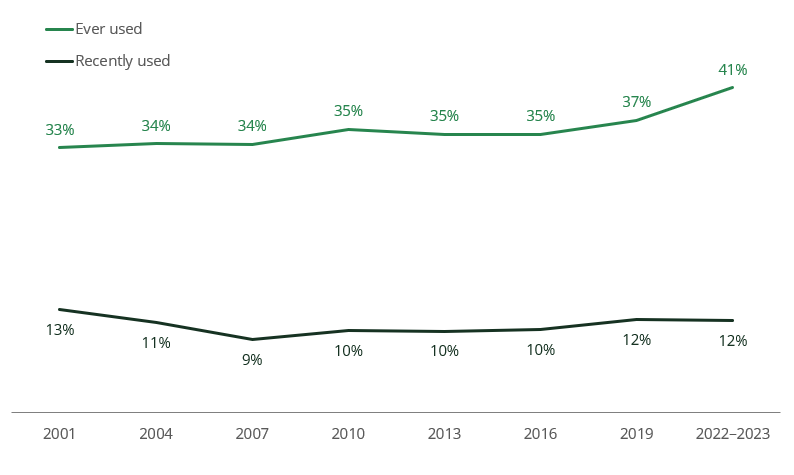
Source: NDSHS 2022–2023, Tables 5.48 and 5.50.
Historically, males have been more likely to have used cannabis than females, and while this remained true in 2022–2023 the gap reduced substantially (Figure 2). This is because males were less likely to have used cannabis in the previous 12 months (13.1%, down from 14.7% in 2019), and females were more likely to have done so (9.8%, up from 8.6% in 2019).
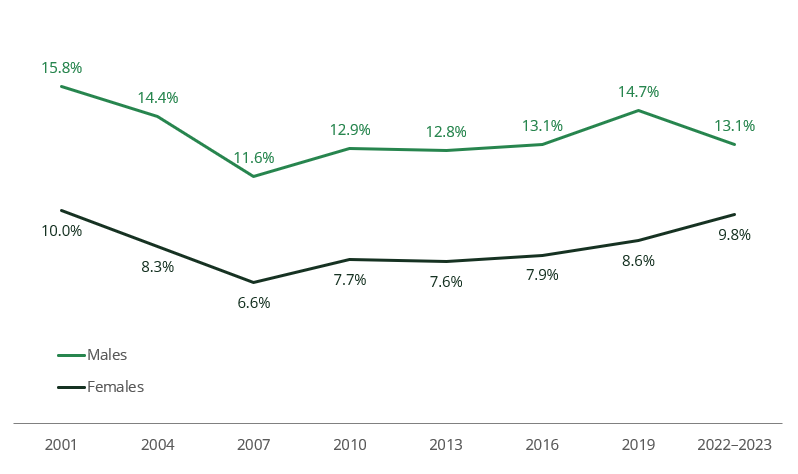
Source: NDSHS 2022–2023, Table 5.50.
Did decriminalisation in the ACT impact cannabis use?
On 31 January 2020, the ACT Government decriminalised possession of some amounts of cannabis, use of cannabis in the home, and growing cannabis plants, for people aged 18 and over. It is illegal to give or sell cannabis to another person, and to use cannabis in a public place (source).
Despite these changes, use of cannabis in the previous 12 months in the ACT remained stable. In 2022–2023, 8.7% of people reported using cannabis in the previous 12 months, consistent with use since 2007 which has ranged between 8.4% and 10.5%. Use of cannabis in the ACT in 2022–2023 was lower than the rest of Australia.
In 2022–2023, people in ACT were much less likely to obtain cannabis from their friends (48%, down from 68% in 2019) with no increase in the proportion of people sourcing cannabis from a dealer (*18.8%, from 18.3% in 2019). People in the ACT were the most likely to have grown their own cannabis (*12.4%, compared with 3.6% nationally).
* Estimate has a Relative Standard Error between 25% and 50% and should be interpreted with caution.
Results for all jurisdictions can be found in this report.
More people who use cannabis may be at risk of problem drug use
‘High risk’ cannabis use
The NDSHS includes a number of questions from the Alcohol, Smoking and Substance Involvement Screening Test (ASSIST-Lite) which categorises use of drugs as ‘low risk’, ‘moderate risk’ and ‘high risk’. High risk scores may indicate a substance dependence problem and are likely to require specialist assessment and treatment for their substance use (Ali et al. 2013).
While use of cannabis overall did not increase substantially since 2019, there were some concerning increases in high risk use of cannabis in 2022–2023. In particular, the proportion of females who had used cannabis in the previous 12 months and were identified as having high risk cannabis use more than doubled, from 1.8%* to 4.8%, while high risk use among males who had recently used cannabis remained stable (3.7% in 2022–2023).
While people aged 14–17 were less likely than most other age groups to have used cannabis in the previous 12 months (9.7% compared with 11.6% for people aged 18 and over), those that did were much more likely to have used cannabis in moderate risk or high risk ways (Figure 3):
- Over 1 in 10 (*11.9%) people aged 14–17 who had used cannabis were identified as high risk, higher than any other age group
- Almost 1 in 4 (*23%) were identified as moderate risk, also higher than any other age group.
* Estimate has a Relative Standard Error between 25% and 50% and should be interpreted with caution.
This was a new result in 2022–2023, as the proportion of people aged 14–17 who had used cannabis and received low risk scores decreased substantially from 88% in 2019 to 65% in 2022–2023.
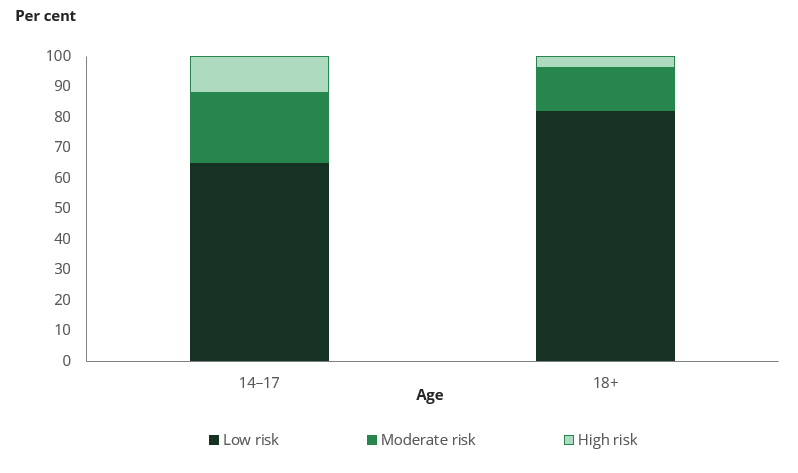
Source: NDSHS 2022–2023, Table 5.59.
Who is more likely to have used cannabis?
As with all illicit drugs, use of cannabis was not uniform across the Australian population in 2022–2023 (Figure 4). Use of cannabis among almost all population groups remained stable between 2019 and 2022–2023.
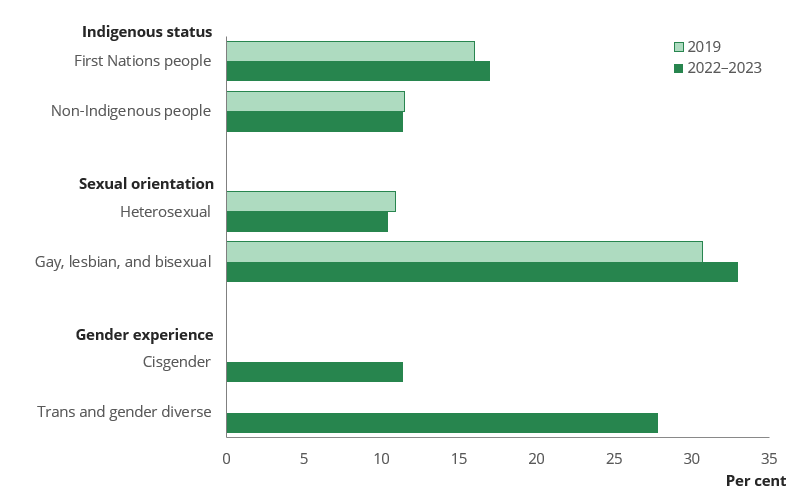
Note: Rates for First Nations people should not be directly compared to rates for non‑Indigenous people due to differences in the age structures between the two populations. Age standardised results can be found in the supplementary data tables.
Source: NDSHS 2022–2023, Table 5.56.
- 1 in 3 (33%) gay, lesbian and bisexual people had used cannabis in the previous 12 months, while only 1 in 10 (10.4%) heterosexual people had done so. After adjusting for differences in age, gay, lesbian and bisexual people were 2.6 times as likely to have used cannabis in the previous 12 months as heterosexual people.
- More than 1 in 4 (28%) trans and gender diverse peoplehad used cannabis in the previous 12 months and were 2.4 times as likely as cisgender people (11.4%) to have done so. This also reflects the broader trend where trans and gender diverse people were 1.9 times as likely to have used any illicit drug in the previous 12 months.
- Almost 1 in 5 (17.0%) First Nations peoplehad used cannabis in the previous 12 months. After adjusting for differences in age, First Nations people were 1.2 times as likely to have done so as non‑Indigenous people.
Public views of cannabis continuing to grow more positive
Public views of cannabis have continued to change since 2013. The 2019 survey marked the first time that more people supported the legalisation of cannabis than opposed it. This continued in 2022–2023, with support for legalisation of cannabis increasing to 45%, and the proportion of people who believed that possession of cannabis should not be a criminal offence reached an all-time high of 80% (Figure 5).
Additionally, 2022–2023 was the first year that the proportion of people supporting legalisation was higher than the proportion of people supporting increased penalties for the sale or supply of cannabis (39%).
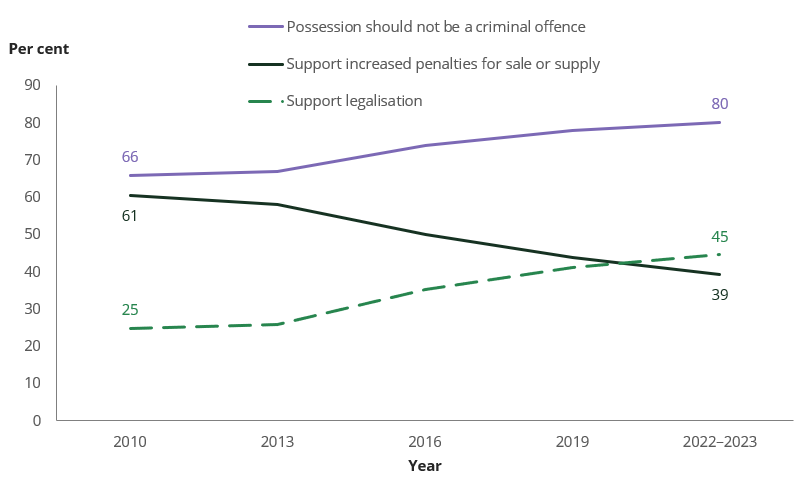
Source: NDSHS 2022–2023, Tables 11.15, 11.23, and 11.27.


